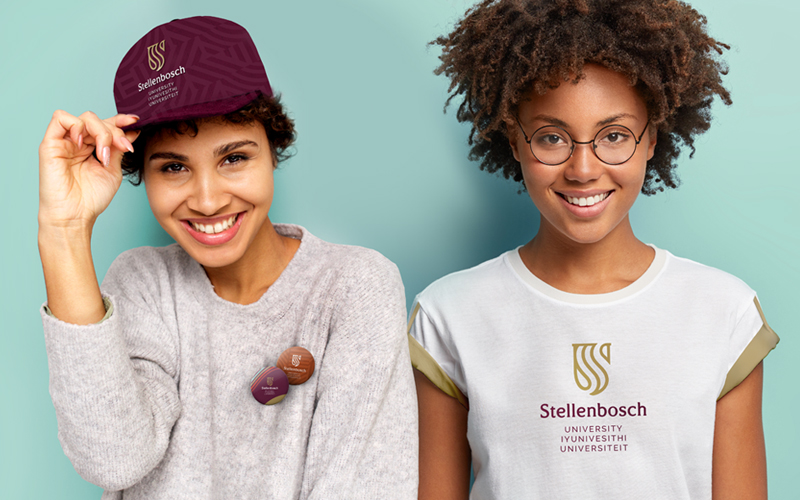New logo for Stellenbosch University – FAQs
empty
empty
COVID-19 has had huge cost implications, so why introduce a new logo now?
The new logo is the outcome of a process that started over two years ago, predating COVID-19. The fact that it coincided with the pandemic was completely unforeseen.
In 2017, the Rectorate approved an Integrated Communication Strategy for Stellenbosch University (SU). One of the stated aims of the strategy was to build a strong brand reputation for the institution that would be in line with the University’s Vision 2040 and Strategic Framework 2019–2024.
The first step to achieve this was a visual touchpoint audit across campus in 2017, followed by a brand valuation and perception audit completed in 2019. These revealed that the SU brand had been diluted over time: Over 170 logos were being used by different University environments. The Rectorate subsequently decided to adopt a uniform brand in order to portray a more consistent image to our audiences.
An audit revealed that over 170 logos were being used by different SU environments, which had diluted the University’s brand.
Another reason for tackling the rebranding project is that SU, like all organisations, continues to evolve. Today’s SU is no longer the institution it was when it launched the ‘S’-leaf logo 21 years ago. The new logo is a creative expression of the changes we have gone through, where we are now, and where we see ourselves going next. It depicts the University as being relevant to the people of our country, continent and the rest of the world; a leading world-class university making meaningful, high-quality contributions that take humanity forward.
What does the rebranding cost?
The first project phases (audits and surveys) were funded from the budget of SU’s Corporate Communication and Marketing Division (CCMD), while the next phase (brand development and design) was funded from SU’s Strategic Fund. We have managed to keep all costs within the approved budget and will continue to manage the project in a cost-effective way.
Now that the new logo has been revealed, the branding agency (Boomtown) and the CCMD branding team will compile a brand manual and toolkit, which will include templates for use by all University entities. At first, the new logo will be applied to our various digital platforms, which will be relatively inexpensive. Then, as SU’s other points of contact with its stakeholders need updating or replacing, the new logo will be gradually phased in, funded from the relevant faculty or support service’s own budget.
Ultimately, having a uniform logo will cut costs, as we will be maintaining a single visual identity as opposed to more than 170.
Who designed the new logo?
The new logo design is a direct reflection of the feedback we received from an extensive engagement process involving students, faculties, staff, alumni and Council members, as well as the broader Stellenbosch community. Building on that foundation, SU’s branding team, staff from the Visual Arts Department as well as the design agency, Boomtown, set about designing the logo, with the assistance of external executive creative counsel.
Who was consulted in the process?
The comprehensive engagement process consisted of two phases – one before logo design started (concluded in November 2020) and another after a few options had been designed (conducted in January and February 2021).
Before design started, 17 online engagement sessions were held with SU staff, students and alumni. An electronic survey was also conducted, in which staff, students, alumni and Council members were invited to participate. Altogether 1 075 stakeholders participated in this engagement phase. The results were collated into a report and formed the basis of the design brief.
After design, with three options on the table, the University’s staff, students, alumni, Council members, Council committee members as well as the broader Stellenbosch community were again approached. This time, we wanted to determine which design option would best achieve SU’s strategic and brand objectives. A total of 2 025 stakeholders participated in this engagement phase.
In total, 3 100 stakeholders contributed to developing and designing SU’s new logo.
What process was followed for approving the new logo?
SU’s normal, prescribed approval route was followed. Before the new logo was submitted for Council’s approval at its meeting on 13 April 2021, it served before the Rectorate as well as the Institutional Forum and Senate – SU’s statutory bodies. This, in turn, was preceded by an extensive engagement process with all key stakeholder groups (see above).
Will the new logo be used on University blazers and sportswear?
The new logo is SU’s public-facing brand and forms the basis of our visual identity. It will be used on all marketing and institutional communication, University apparel (blazers, sportswear, etc.) and merchandise.
Has maroon been retained as the primary brand colour?
In the brand valuation, our stakeholders indicated that the colour maroon, more than any other colour, differentiated SU from its competitors. This is why it has been retained as SU’s primary brand colour.
Yet the new logo also introduces gold to add vibrancy and symbolise SU’s commitment to excellence. And depending on the application of the logo, an extended colour palette will be used, incorporating earthy tones that will echo the natural beauty surrounding the University.
How does the new logo affect SU’s slogan?
Stakeholders felt strongly that the institutional slogan developed for SU’s Centenary, namely “forward together, sonke siya phambili, saam vorentoe”, had to be retained. The general sentiment was that it represented SU’s mission (to be “a research-intensive university where we attract outstanding students, employ talented staff and provide a world-class environment; a place connected to the world, while enriching and transforming local, continental and global communities”).
The isiXhosa phrase has been changed slightly from “masiye phambili” to “sonke siya phambili”, as isiXhosa language experts indicated the latter to be a more accurate translation of “forward together”.
What was the reasoning behind the new SU logo design?
In the consultative process, stakeholders said they wanted:
- a simple and modern, yet striking and sophisticated design, portraying an institution of world-class academic stature;
- an abstract design to avoid cultural sensitivities, along with an element of ‘movement’ to reflect ongoing transformation; and
- a balance between heritage and tradition on the one hand and a focus on the future on the other, to ensure recognisability, while also illustrating the future that SU is aiming for.
The result is a modern and streamlined yet classic and elegant design. It is also legible, clear and recognisable. In addition, the fact that the ‘S’ and ‘U’ of ‘Stellenbosch University’ are contained in a single visual element makes the logo well suited for digital applications.
How does the design depict SU’s connection with Africa?
The new logo illustrates SU’s Vision 2040, namely to be Africa’s leading research-intensive university that is globally recognised as excellent, inclusive and innovative, advancing knowledge in service of society.
In the logo design, this connection with Africa is expressed through the rhythmic effect of the ‘S’ lines. The continuous flow and movement of the lines signifies the warmth, vibrancy and pulsing energy of our continent, as well as the dynamic creativity of SU and its people.
It is also proposed that the logo be used in Africa-inspired layouts and designs that feature the distinctive patterns, vivid colours and images of our continent.
Explain the thinking behind the sequence of the languages used in the logo?
As a national asset, SU pursues inclusive multilingualism. The University uses the three official languages used in the Western Cape, where the institution is located, i.e. Afrikaans, English and isiXhosa.
The sequence of the languages in the logo does not represent any kind of ranking – none of the languages is more important than the others. From a symbolic perspective, the sequence makes sense: Afrikaans (“Universiteit”) forms the foundation, signifying SU’s origins; the isiXhosa “iYunivesithi” in the middle reflects SU’s increasing diversity, while the English “University” speaks to internationalisation and SU’s connectedness to the rest of the world.
Does the logo change the University’s official name?
No. Our name remains as indicated in our Statute, in both spoken and written form, namely “Stellenbosch University” in English, “Universiteit Stellenbosch” in Afrikaans, and “iYunivesithi yaseStellenbosch” in isiXhosa.
What happens next in terms of the rebranding project?
Council’s approval of the new logo on 13 April 2021 was the first major milestone in developing SU’s new visual identity.
The logo will now be registered as a trademark.
We will also develop a comprehensive and integrated visual identity system. This system will take the form of a manual and toolkit, which will provide guidelines on how to use the new logo, as well as templates for use across the University. It should take a few months to complete.
When is the official launch of the new logo, and when can I start using it?
Once the new logo has been registered as a trademark and the visual identity system has been developed, there will be an official launch, after which roll-out and implementation will start. Until then, the current SU (Centenary) logo remains in place.
How will I be kept informed of developments regarding the new brand?
SU’s Corporate Communication and Marketing Division (CCMD) will provide updates on SU’s homepage and via e-newsletters and mass mailers.


